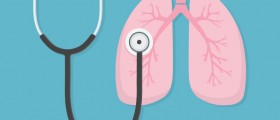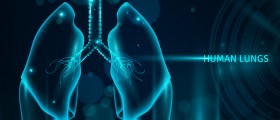
Restrictive lung disease includes extrapulmonary, pleural or parenchimal respiratory illnesses which cause restriction of lung movement, to be more precise lung expansion. This consequently leads to decreased lung volume, breathing difficulties and improper supply with oxygen.
In restrictive lung disease lung compliance is lost. Lung compliance is the ability of the lungs to stretch due to a change in volume according to applied change in pressure. This limitation of lung movement causes symptoms such as shortness of breath. The underlying cause of restrictive lung disease is pulmonary fibrosis. It features with scarring of the lung tissues. Normal functional alveoli are replaced with nonfunctional scar tissue which simply is not elastic enough and does not allow the lungs to expand properly. Progression of the disease leads to less and less oxygen supply which causes low saturation of this gas in blood.
Causes of Restrictive Lung Disease
This condition may be a consequence of exposure to asbestos. So it typically occurs due to asbestosis. It may also affect people suffering from rheumatoid arthritis and hypersensitivity pneumonitis.
Symptoms of Restrictive Lung Disease
This condition features with two symptoms, shortness of breath and cough. Shortness of breath is initially compensated while progression of the disease eventually leads to insufficient oxygen supply and cyanosis.
Diagnosis of Restrictive Lung Disease
If a doctor assumes a patient is suffering from restrictive lung disease he/ she performs functional lung test called spirometry. A patient's FEV1/FVC ratio is measured and checked. The FEV1 represents the amount of air a patient can blow out in the duration of one second. The FVC refers to the total air that may be exhaled after full inspiration. The specific FEV1/FVC ratio in patients suffering from restrictive lung disease is higher comparing to normal values. The total lung capacity and residual volume are also measured. They show a general decline in patients suffering from restrictive lung disease. For definitive confirmation of the condition patient's total lung capacity must be below 80% of its normal value.
Treatment for Restrictive Lung Disease
There is no definitive cure for restrictive lung disease since the process which includes replacement of lung tissue with fibrous tissue is simply irreversible. Unfortunately, all the available treatment modalities are not so effective. The symptoms may be only partially alleviated. The goal of the therapy is to supply a patient with proper amount of oxygen. This can be successfully achieved only in early stage of the disease. It is essential to treat the underlying cause of restrictive lung disease.









_f_280x120.jpg)


,-Asthma-And-Anxiety_f_280x120.jpg)




Your thoughts on this
Loading...